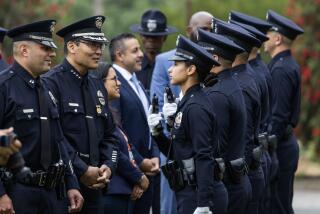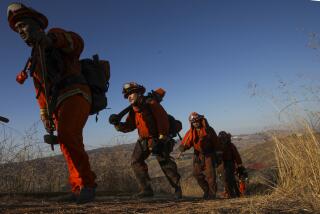Weekend Warriors’ Comeback : The California National Guard, hard-hit by cutbacks, for years endured parts shortages and limits on training. But now, thanks in part to a growing role in the military, an influx of money is funding its modernization.
After years of cutbacks, the citizen soldiers California turns to in times of trouble have begun to receive a new infusion of money and modernized gear.
At National Guard armories across Southern California, money for spare parts simply dried up through much of the 1990s, as the nation’s military downsized.
During the worst of it two years ago, platoon sergeant Kenneth La Mere recalls, about 90% of the vehicles at his Gardena armory were inoperable.
“You’d have to take parts from one to fix the other so you could get out of the yard,” said the 51-year-old Pico Rivera resident.
This year, the budget for repair parts has more than doubled and about 70% of his unit’s vehicles are ready to go, La Mere said.
More important for the state’s 16,500 army guard members--most of whom are only part-time soldiers and work civilian jobs--is that additional training and education opportunities are opening up.
Until this year, guard members were forced to make a difficult choice. They could either drill in the field with their units for two weeks during the summer or attend a school in their area of specialty.
Now, funds are available for most guard members to do both.
“That was the main problem,” said Sgt. 1st Class Clarence Johnson of Colton. “People were getting out because they weren’t being trained in what they came in to do.”
In addition, upgraded tanks, more heavy-lift helicopters, sophisticated armored personnel carriers and faster, beefier trucks are starting to arrive in the state as part of major equipment modernization that will span the next several years.
Primarily, the improvements are supposed to enhance the guard’s military preparedness and, eventually, place it on a more equal footing with the regular Army.
But the changes also will pay dividends during state emergencies.
“We’re probably better equipped than we were during the Northridge earthquake,” said Maj. Gen. Paul Monroe Jr., the guard’s top commander statewide. “And I thought we did a good job then.”
Although Monroe stresses that the guard is ready for California disasters, its preparedness has been a concern in the past. A 1993 study commissioned by former Gov. Pete Wilson found problems with inadequate training and getting equipment quickly to Southern California during the Los Angeles riots.
The guard made a series of corrections afterward and has been tested repeatedly since then in natural disasters.
More Missions Than Other States
Commanders like to note that from 1992 through 1995, the California guard was called out for more emergency missions than the guard units in all other states combined.
In the latest deployment, troops last week backed up firefighters in Northern California, while Black Hawk helicopters from Los Alamitos flew hundreds of water-dropping sorties over Southern California wildfires.
The guard now is gearing up for possible Y2K disruptions. Some 2,000 troops will be on duty New Year’s weekend around the state and hundreds more will be on call in key metropolitan areas.
The guard’s revival has a long way to go.
In a cluster of brick buildings in Long Beach, the guard’s biggest repair facility in Southern California, Sgt. Robert Argenal last week was bolting a new transmission into a 2 1/2-ton troop carrier, trying to bring the tired rig back to life.
The chalky brown, camouflaged workhorse is older than many of the soldiers who drive it.
Argenal, a mechanic from El Monte, said that training may be up but morale is down, partly because of delays in getting pay bonuses.
And he said he still has to set aside half-finished repairs because parts “seem hard to get.”
A short walk away is another measure of the continuing challenges.
They call it the “dead line.”
Long columns of broken down Humvees, trucks and big haulers stretch across nearly eight acres. They have been collected from armories across the region and each awaits a mechanic’s hand, delayed parts or both.
Funding to pay full-time technicians and mechanics such as Argenal has continued to decline, officials say, making it difficult to break a backlog of major repair jobs here and elsewhere.
“It’s nothing for a unit to send in a truck with a blown engine and have to wait nine to 12 months to get the truck back,” said Lt. Col. Jacob vanGoor, chief of staff of the state’s largest division.
Several guardsmen agreed with a sergeant from an artillery company in the San Fernando Valley.
“It was horrible,” he said. “Now, it’s not the best, but the situation is improving.”
Reversing the Downward Spiral
A number of factors figured in reversing the downward spiral for the guard nationally, and California’s units in particular.
A formidable network of guard supporters helped win a boost in funds in the current federal budget, despite some studies that said many guard units have no clear role in the country’s current war-fighting strategies.
“They could beat the [doctors’ lobby] hands down,” said a Washington official familiar with the guard’s clout on Capitol Hill. “They have people in every state and those people are aware and informed.”
At the same time, the U.S. Army, already downsized by about one-third, is becoming increasingly dependent on selected guard units--including several in California--for combat support.
In a deft move last year, California commanders were the first in the country to voluntarily agree to “trade in” some fighting units for higher priority supply teams.
The converted units will transport personnel and equipment, haul fuel and assist regular Army units in wartime construction projects.
Taking a back seat to the Army, a longtime rival, has not been popular with some guard members. But the move helped put the entire California guard near the top of the Pentagon’s list for modernization and additional funding, officials said.
This year, the state guard’s operating budget, including money for some special overseas operations, rose about 10% to $220 million, after dipping during the mid-1990s.
A turning point for California came in late 1997.
Concerned that the guard was deteriorating and Army brass was ignoring it, the then-commander of the state’s large 40th Infantry Division (mechanized), publicly complained about his unit’s woeful state of combat readiness.
“We didn’t have the equipment or the parts to maintain what we had,” recalled retired Brig. Gen. Edmund Zysk.
“I was going to have problems accomplishing the mission given to me. I had to speak out.”
Candor of that type normally is not appreciated in the military chain of command. Zysk expected a chewing out when he was summoned to the National Guard headquarters in Washington.
Instead, he was praised for exposing the problems, and soon Army Chief of Staff Gen. Dennis Reimer asked to meet with Zysk in California.
“It’s very unusual for a four-star [general] to ask to meet with a division commander, especially a National Guard commander,” Zysk said. “But he wanted to know about the funding shortage and equipment problems.”
Reimer spent two days getting a firsthand look at the problems. Soon the California Guard got its first additional training funds in years.
One of the greatest difficulties facing the guard now is retaining trained soldiers.
About one-third of the guard personnel turns over each year, said Monroe, the adjutant general. Only a highly effective recruitment effort is keeping the guard near its full complement of funded positions.
The problem is affecting all of the military, partly because the thriving economy is presenting better employment options.
In California, shortages of qualified personnel are developing in fields like technology. “We have computers like everyone else,” Monroe said. “We send people to computer schools and then corporations offer them better deals.”
Conflicts With Careers, Finances
In addition, with more call-ups for disasters and extended overseas duty in places like Bosnia, the stresses on families and finances, as well as conflicts with employers, are multiplying
One of the guard’s air ambulance units recently spent nine months in the Balkans.
“We’re doing more missions now with less people than we were 10 years ago,” said vanGoor, the 40th Division chief of staff.
During activation, some guard members receive only military pay, which can mean sharp losses of income, officials said.
“It’s not good,” Capt. Greg Atencio said last week, as he supervised a crew servicing Los Alamitos choppers working on the wildfires. He was talking about the financial hardships created when part-time guard personnel are called and lose their regular salaries.
Atencio tries to use full-time paid technicians, active duty guard members and part-time guard volunteers to handle emergencies.
But increasingly, he must order mechanics from the part-time ranks to the airfield in emergencies, causing problems at work.
“We’re not well manned, [and] some employers just aren’t cooperating,” he said.
Federal laws are supposed to protect guard members’ jobs, but resistance can be subtle, commanders say.
“A soldier who takes time off for training may not get a promotion that he or she deserves,” said Maj. Stanley Zezotarski, a California National Guard spokesman.
Monroe, appointed by Gov. Gray Davis in May, said he is trying to “reduce the turbulence” in guard life for part-timers by making training schedules more predictable. He has set new goals for reenlistments, and expects the new noncombat support units to open up more recruiting opportunities among women.
It remains to be seen how far and fast the California Guard can rebound with the new money, new equipment and new partnership with the Army.
The big test ahead will be convincing a new generation of more economically mobile weekend warriors to stay around long enough to find out.
(BEGIN TEXT OF INFOBOX / INFOGRAPHIC)
Good News for California National Guard
Through much of the 1990s, funding for the California National Guard dwindled in response to nationwide military budget cuts, but there is good news for Southern California armories. The budget for repair parts has more than doubled and additional training and education oppor-tunities are also opening up.
* Source: California National Guard
More to Read
Sign up for Essential California
The most important California stories and recommendations in your inbox every morning.
You may occasionally receive promotional content from the Los Angeles Times.










